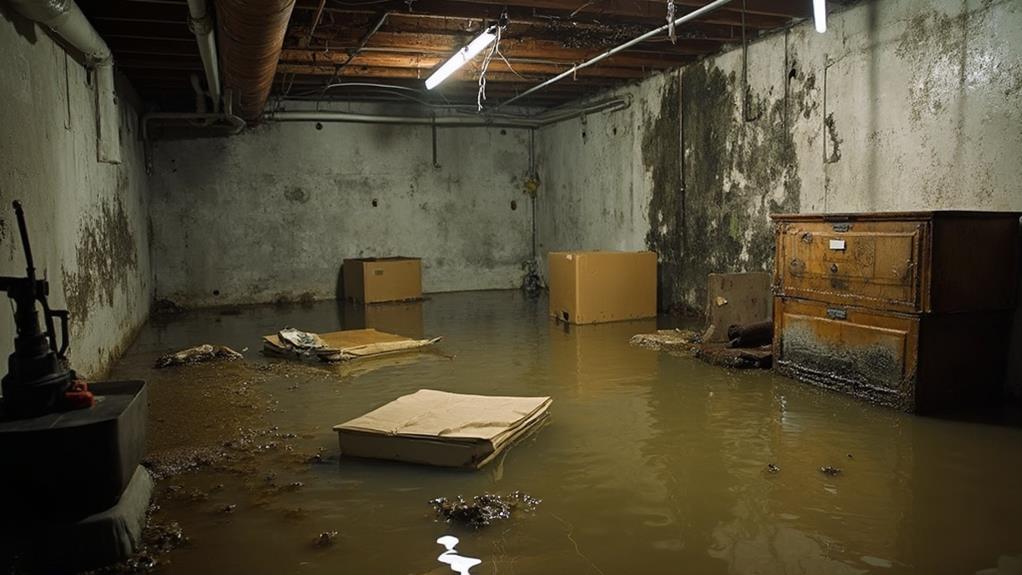When faced with standing water in your basement, act quickly to minimize damage. First, assess the situation and identify the water source. Remove standing water using a wet/dry vacuum or submersible pump, depending on depth. Dry and ventilate the area thoroughly with fans and dehumidifiers. Clean and disinfect all surfaces to prevent mold growth. Repair damaged areas, including walls, floors, and electrical systems. Address underlying causes by improving drainage and sealing foundation cracks. Implement preventive measures like installing a sump pump or upgrading waterproofing. Following these steps can help restore your basement and safeguard against future flooding incidents.
Assess the Situation
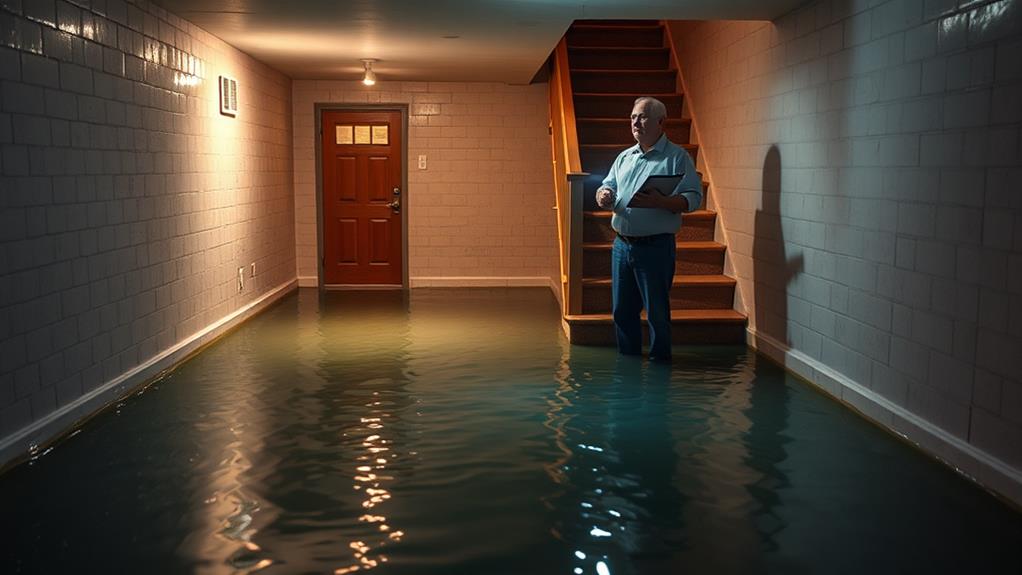
The first step in addressing standing water in your basement is to assess the situation thoroughly. Determine the extent of the water damage, including the depth of standing water and affected areas. Identify potential sources of the water, such as heavy rainfall, plumbing leaks, or foundation cracks. Check for any immediate safety hazards, like electrical outlets or appliances in contact with water.
Evaluate the water's color and odor, as these can indicate whether it's clean water from a pipe leak or contaminated water from sewage backup. Look for signs of mold growth, which can develop rapidly in damp environments. Inspect walls, floors, and personal belongings for water damage and document everything for insurance purposes.
Consider the duration of the flooding, as prolonged exposure increases the risk of structural damage and mold growth. Assess the basement's ventilation and determine if additional equipment like fans or dehumidifiers is necessary. Finally, gauge your ability to handle the situation alone or if professional help is required, especially for extensive flooding or potentially hazardous conditions.
Identify the Water Source
Identifying the water source is crucial for effectively addressing basement flooding and preventing future occurrences. Common sources include:
- Plumbing leaks: Check for burst pipes, faulty water heaters, or malfunctioning appliances.
- Foundation cracks: Inspect walls and floors for visible cracks allowing water infiltration.
- Window wells: Ensure proper drainage and sealing around basement windows.
- Sump pump failure: Verify if the sump pump is functioning correctly or needs replacement.
- Sewage backup: Look for signs of contaminated water, which requires immediate professional attention.
- Groundwater seepage: High water tables or poor lot grading can lead to water intrusion.
- Surface runoff: Inadequate gutters, downspouts, or landscape grading may direct water toward the foundation.
To pinpoint the source, observe water patterns, check for dampness on walls or floors, and listen for running water sounds. Use a moisture meter to detect hidden water damage. If the source remains elusive, consider hiring a professional water damage specialist or plumber to conduct a thorough inspection.
Once identified, take appropriate measures to address the specific issue and implement preventive strategies to safeguard your basement against future flooding.
Remove Standing Water
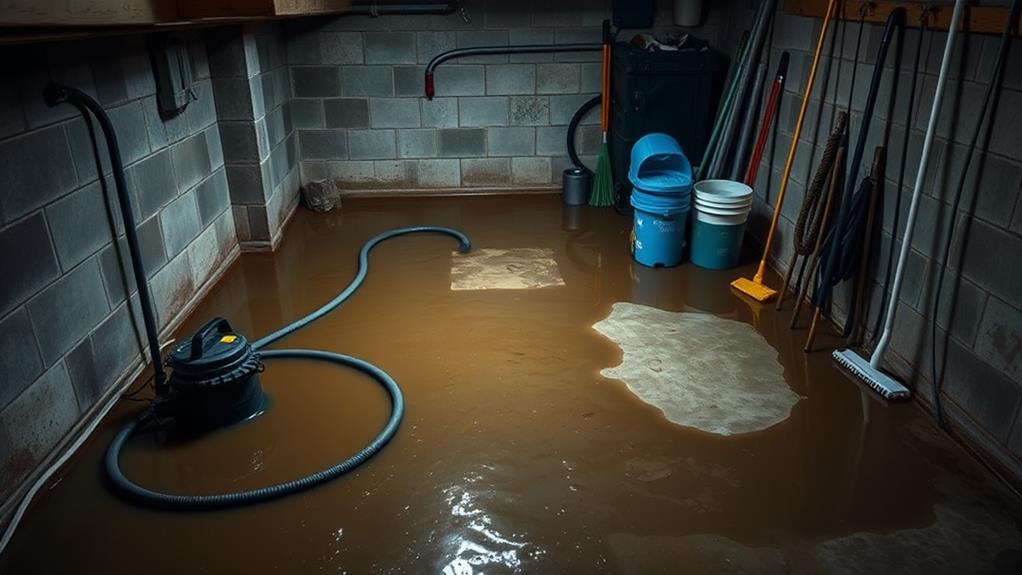
After identifying the water source, immediate action is required to remove standing water from the basement. The most effective method depends on the water depth and available equipment. For shallow water (less than 1 inch), a wet/dry vacuum can efficiently extract the moisture.
For deeper water, submersible pumps are more suitable and can be rented from hardware stores if not owned.
When using a pump, place it at the lowest point of the basement and direct the discharge hose outside, away from the foundation. Ensure the pump has a proper power source and monitor its operation. For large volumes of water, multiple pumps may be necessary. Once the majority of water is removed, use mops, towels, or sponges to absorb remaining moisture.
Safety is paramount during this process. Wear protective gear, including rubber boots and gloves, to avoid contact with potentially contaminated water. If the water level is high or there's a risk of electrical hazards, consult professionals. After water removal, initiate the drying process immediately using fans and dehumidifiers to prevent mold growth and further damage to the basement structure and contents.
Dry and Ventilate
Once standing water has been removed, drying and ventilating the basement becomes the critical next step in mitigating water damage. Begin by opening all windows and doors to promote air circulation. Use high-powered fans strategically placed to direct airflow across damp surfaces.
Dehumidifiers are essential for reducing moisture levels in the air, preventing mold growth and further structural damage.
Remove wet carpets, furniture, and other porous materials from the affected area. These items should be dried separately or discarded if severely damaged. Use a wet/dry vacuum on remaining damp surfaces to extract residual moisture. For concrete floors and walls, consider using a squeegee to push excess water towards drains or sump pumps.
Monitor humidity levels using a hygrometer, aiming for 30-50% relative humidity. Continue running fans and dehumidifiers until moisture readings indicate safe levels. This process may take several days, depending on the extent of water damage. For severe cases or if mold growth is detected, consult professional water damage restoration services. They possess specialized equipment and expertise to ensure thorough drying and prevention of secondary damage.
Clean and Disinfect
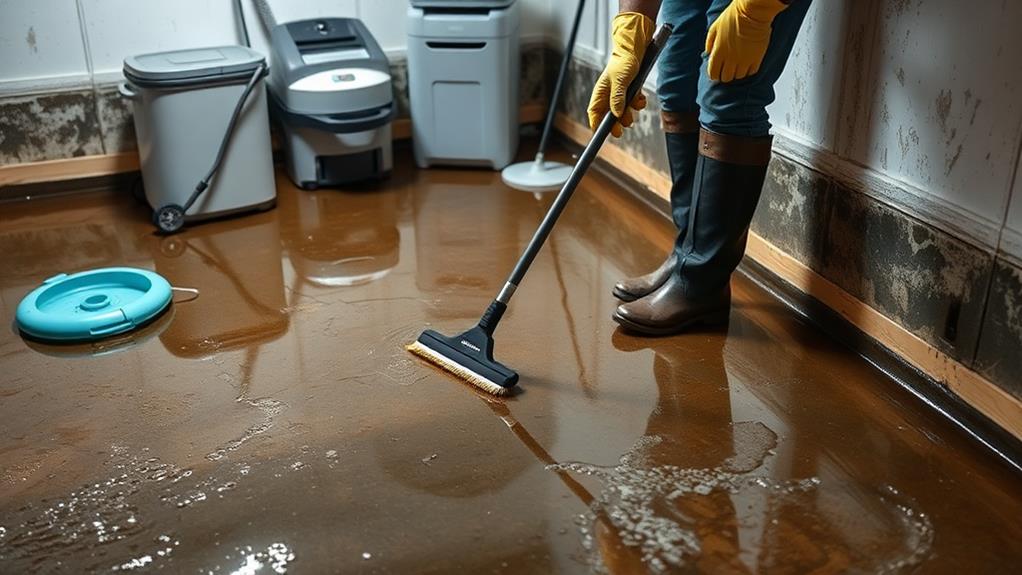
Cleanliness is paramount in the aftermath of basement flooding. Once the area is dry and well-ventilated, thorough cleaning and disinfection are essential to prevent mold growth and eliminate potential health hazards.
Begin by removing any remaining debris and disposing of contaminated materials that cannot be salvaged.
Scrub all surfaces, including walls, floors, and fixtures, with a mixture of hot water and non-ammonia detergent. Pay special attention to corners, crevices, and hard-to-reach areas where contaminants may accumulate. Rinse thoroughly with clean water to remove all soap residue.
After cleaning, disinfect all surfaces using a solution of one cup of bleach per gallon of water. Allow the disinfectant to remain on surfaces for at least 10 minutes before rinsing. For items that cannot be bleached, use an EPA-registered disinfectant following the manufacturer's instructions.
Don't forget to clean and disinfect any tools or equipment used during the cleanup process. Wear protective gear, including gloves, boots, and a respirator, throughout the cleaning and disinfection process to ensure your safety. Finally, properly dispose of any contaminated cleaning materials to prevent further spread of contaminants.
Repair Damaged Areas
With the cleaning and disinfection process complete, addressing any structural damage caused by the standing water becomes the next critical step. Begin by thoroughly inspecting walls, floors, and ceilings for signs of water damage, such as warping, cracking, or discoloration. Pay close attention to wooden structures, as they are particularly susceptible to rot and mold growth.
For damaged drywall, cut out and replace affected sections, ensuring proper insulation is reinstalled. Repair or replace any compromised flooring, whether it's hardwood, laminate, or carpet. If concrete floors show signs of cracking or deterioration, consult a professional for appropriate repairs.
Check electrical systems, including outlets, wiring, and appliances, for water damage. Have a licensed electrician inspect and repair any compromised components to prevent safety hazards. Examine support beams and foundation walls for structural integrity, addressing any issues promptly to maintain your home's stability.
Address Underlying Causes
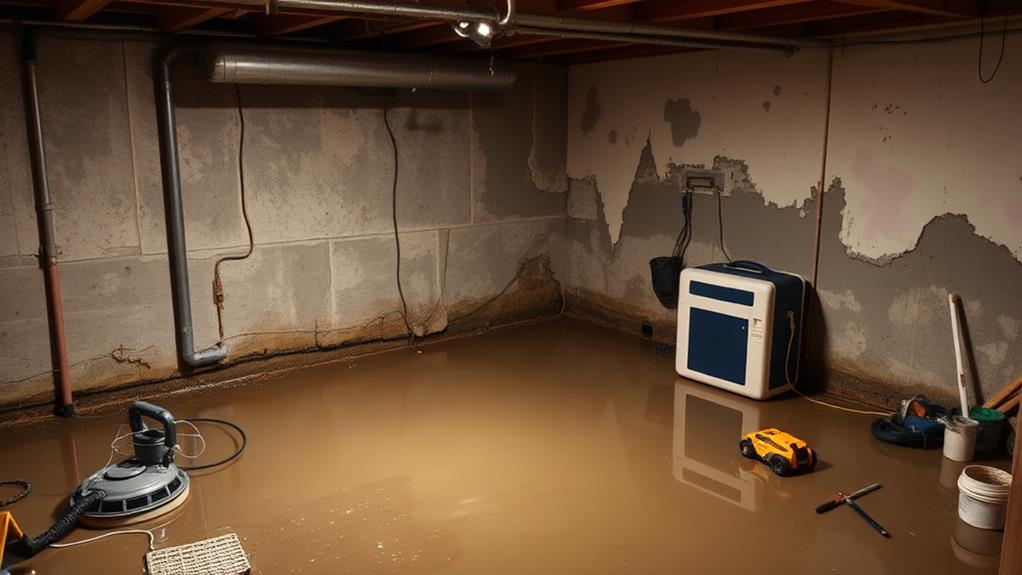
Addressing the underlying causes of standing water in your basement is crucial to prevent future occurrences. Begin by identifying the source of water intrusion. Common culprits include poor drainage, foundation cracks, or faulty waterproofing.
Inspect your gutters and downspouts, ensuring they're clear of debris and directing water away from your foundation. Grade the soil around your home to slope away from the structure, promoting proper runoff.
For foundation issues, seal any visible cracks with hydraulic cement or epoxy injections. Consider installing a French drain system to redirect groundwater away from your basement. If your area has a high water table, a sump pump may be necessary to manage water levels.
Evaluate your basement's waterproofing system and repair or upgrade as needed. This may involve applying waterproof sealants to walls and floors or installing a vapor barrier.
In some cases, professional assessment may be required to address complex drainage issues or severe structural problems. Regularly maintain your basement's waterproofing measures and drainage systems to ensure long-term protection against standing water. By tackling these underlying causes, you can significantly reduce the risk of future water accumulation in your basement.
Implement Preventive Measures
A robust defense against future water intrusion involves implementing preventive measures in and around your basement. Begin by installing a sump pump system to automatically remove excess water. Ensure the pump is properly sized for your basement and includes a battery backup for power outages.
Apply waterproof sealants to basement walls and floors, creating a barrier against moisture penetration. Install a French drain system around the perimeter of your home to divert groundwater away from the foundation.
Maintain proper grading around your house, sloping the soil away from the foundation to prevent water accumulation. Clean and repair gutters and downspouts regularly, extending downspouts at least 5 feet from the foundation. Consider installing window wells with covers for basement windows to prevent water entry.
Use dehumidifiers to control moisture levels in the basement, maintaining relative humidity below 50%. Insulate water pipes to prevent condensation and potential leaks. Regularly inspect and maintain plumbing systems, fixing any leaks promptly.
Monitor and Maintain
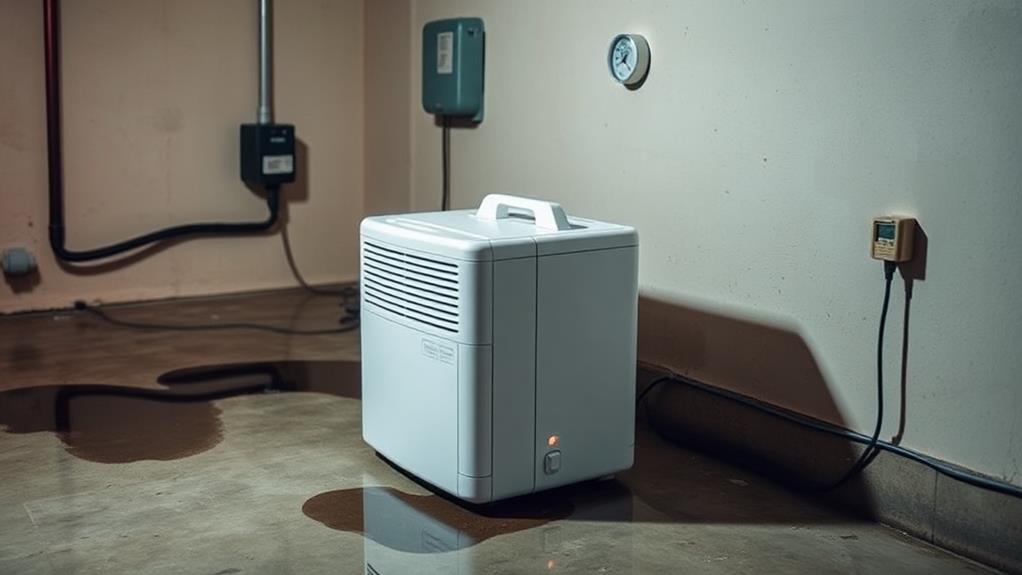
Ongoing vigilance is crucial to maintaining a dry basement after implementing preventive measures. Regularly inspect your basement for signs of moisture, such as dampness, musty odors, or water stains. Check the sump pump's functionality monthly by pouring water into the pit and ensuring it activates properly. Clean the pump and its components annually to prevent clogs and maintain efficiency.
Examine gutters and downspouts seasonally, clearing debris and ensuring proper water flow away from the foundation. Inspect the grading around your home's perimeter, maintaining a slope that directs water away from the structure. Monitor indoor humidity levels, using a dehumidifier if necessary to keep relative humidity below 60%.
Periodically review your waterproofing systems, including foundation sealants and drainage tiles, for any signs of wear or damage. Address any cracks in the foundation or walls promptly to prevent water intrusion. Keep an eye on nearby trees, trimming roots that may encroach on your foundation and cause damage. By maintaining these preventive measures and addressing issues promptly, you can significantly reduce the risk of standing water in your basement.
Frequently Asked Questions
Is Standing Water in the Basement Covered by Homeowners Insurance?
Homeowners insurance coverage for standing water in the basement depends on the cause. Sudden, accidental events like burst pipes are typically covered. However, gradual seepage or flooding from external sources is often excluded. Review your policy for specifics.
How Long Can Standing Water Remain Before Causing Structural Damage?
Standing water can cause structural damage within 24 to 48 hours. The extent of damage depends on factors like water depth, duration, and building materials. Swift action is crucial to prevent mold growth and deterioration of structural elements.
Can I Use a Regular Vacuum Cleaner to Remove Standing Water?
Did you know that a standard vacuum can only handle about 1/4 inch of water? Using a regular vacuum cleaner for standing water is not recommended. It can damage the machine and pose electrical hazards. Use a wet/dry shop vacuum instead.
Are There Health Risks Associated With Standing Water in the Basement?
Yes, standing water in basements poses significant health risks. It can lead to mold growth, bacterial contamination, and attract pests. Prolonged exposure may cause respiratory issues, allergic reactions, and other health problems. Prompt removal and proper cleanup are essential.
Should I Call a Professional or Attempt to Handle It Myself?
Picture a flood of expertise washing away your worries. While minor water issues can be tackled independently, significant standing water often requires professional intervention. Assess the extent of the problem and your own capabilities before deciding on the best course of action.
Conclusion
In the battle against basement flooding, vigilance serves as the lighthouse guiding homeowners through treacherous waters. Swift action, akin to bailing out a sinking ship, prevents further damage. Thorough cleaning and repairs rebuild the foundation's strength. Addressing root causes acts as a levee against future inundations. Preventive measures form an impenetrable dam, while ongoing maintenance becomes the watchful eye, ensuring the basement remains a dry sanctuary in the storm of potential water intrusion.
